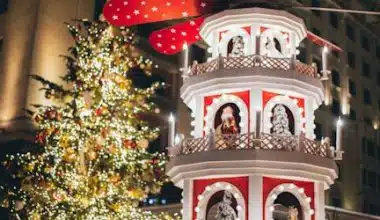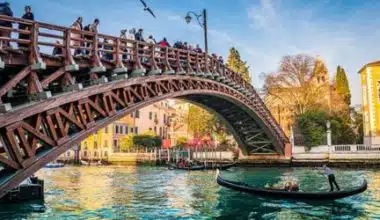Mexico is known for its rich cultural heritage and spectacular celebrations that enchant both locals and visitors. Mexico’s joyful mood is strongly established in its history and traditions, from ancient ceremonies to colorful fiestas. The Day of the Dead is a well-known and extensively observed event in Mexico. In this thorough guide, we will delve into the intriguing tapestry of celebrations in Mexico, delving into the beautiful realm of Day of the Dead festivities and uncovering other engaging cultural festivals throughout the country.
Celebrations in Mexico
Let’s take a peek at some of the celebrations in Mexico below:
#1. Mexico’s Day of the Dead Celebrations
The Day of the Dead, or “Da de los Muertos,” is one of Mexico’s most distinctive celebrations. Rooted in indigenous beliefs and inspired by Catholic traditions, this one-of-a-kind occasion serves as a melancholy commemoration of loved ones who have died. Families and communities gather from October 31 to November 2nd to recognize and celebrate the cycle of life and death.
During the Day of the Dead, families build elaborate altars known as “ofrendas,” which are decorated with marigolds, candles, photos, and the departed’s favorite foods and beverages. The souls of the deceased are said to return to visit their loved ones, and the ofrendas serve as a welcoming space for their spirits. The streets are filled with vibrant parades and exuberant music, creating an atmosphere of joy and celebration amid reflection and remembrance.
#2. Guelaguetza Festival: A Cultural Extravaganza
The Guelaguetza Festival, celebrated yearly in Oaxaca, is a vivid celebration of Mexico’s indigenous tribes’ rich cultural history. This event brings together diverse ethnic groups from the region, showcasing their traditions, dance performances, music, and vibrant costumes. The Zapotec word guelaguetza, which means “offering” or “mutual exchange,” wonderfully captures the spirit of this festivity.
During the Guelaguetza Festival, indigenous people congregate on the old Cerro del Fortn, which overlooks Oaxaca City. They perform traditional dances, music, and crafts for tourists, producing an enthralling display of cultural diversity. The celebration promotes and preserves indigenous customs, creating pride and togetherness among various groups while allowing outsiders to appreciate the beauty and depth of Mexico’s indigenous heritage.
Veracruz, a Mexican coastal city, is famous for its raucous Carnaval celebrations. This yearly celebration, performed in the weeks preceding Lent, includes music, dance, and colorful costumes, bringing thousands of visitors from all over the world. Parades, music bands, and extravagant floats fill the streets of Veracruz, creating an irresistibly festive mood.
The Carnaval de Veracruz, which dates back to the nineteenth century, has evolved into one of Mexico’s most important celebrations of culture. Traditional dances, such as the “Danza de los Voladores” (Dance of the Flyers), in which performers mount tall poles and gracefully drop while linked to ropes, pay homage to ancient rituals and signify the relationship between earth and sky. Carnaval de Veracruz’s infectious energy and exuberant attitude make it a must-attend celebration for visitors looking for a memorable cultural experience.
#4. Semana Santa: A Time of Spiritual Reflection
Semana Santa, or Holy Week, is a prominent religious festival in Mexico that commemorates Jesus Christ’s passion, death, and resurrection. This mournful season, which usually occurs in late March or early April, is observed with great religious zeal throughout the country. Semana Santa delivers a meaningful and thoughtful experience, from processions and reenactments to religious ceremonies and rituals.
Semana Santa begins with magnificent processions in cities such as Taxco, San Miguel de Allende, and Oaxaca, with participants dressed in biblical garb and carrying religious sculptures through the streets. These processions, accompanied by solemn music and prayers, create a contemplative environment that inspires reflection and introspection. The week finishes with Easter Sunday, a day of celebration and gladness when Mexicans gather to celebrate Jesus Christ’s resurrection.
#5. Independence Day: A Proud National Celebration
Mexico’s Independence Day, observed on September 16th, is a historic occasion commemorating the country’s independence from Spanish dominance. This national celebration is full of patriotic pride, vivid parades, and passionate displays of Mexican culture. As the entire country comes together, the streets resound with “Viva México!” chants, and the colors of the Mexican flag cover the landscape.
The festivities begin on September 15th with the renowned “Grito de Dolores” (Cry of Dolores), reenacting Miguel Hidalgo’s call to arms during Mexico’s war for independence. The president and local dignitaries repeat this historic shout, igniting a flurry of excitement and patriotic fervor among the onlookers. Fireworks light up the night sky, and traditional music and shouts of “Viva México!” fill the air. The next day, parades and cultural activities take place around the country, reflecting Mexico’s rich past and the indomitable spirit of its people.
#6. La Callejoneada: A Festive Journey through Guanajuato’s Alleyways
Guanajuato, located in the heart of Mexico, is noted for its spectacular La Callejoneada celebrations. The Callejoneada is a traditional street parade that mixes music, dance, and theatrical acts to create a vibrant and immersive experience. Participants embark on a happy tour through the city’s tortuous streets, led by “Estudiantes,” groups of musicians dressed in traditional student clothing.
As the procession moves through the streets of Guanajuato, revelers join in on the fun. Musicians deliver vibrant tunes for the audience, while performers entertain with humorous skits and dances. La Callejoneada encapsulates Guanajuato’s cultural energy, offering a one-of-a-kind opportunity to immerse oneself in the city’s rich history and creative traditions. This celebration genuinely epitomizes Mexico’s love of music, laughter, and communal revelry.
#7. Las Posadas: Celebrating the Journey of Mary and Joseph
Las Posadas is a nine-day Christmas festival that reenacts Mary and Joseph’s quest for lodging before the birth of Jesus. This festive event, rooted in Catholic traditions, mixes religious rites with pleasant gatherings, highlighting the themes of faith, hospitality, and community.
Every evening, a procession of individuals carrying candles and singing traditional songs marches through the neighborhood to represent Mary and Joseph’s search for shelter. The procession concludes at a specified residence with a reenactment, prayers, singing, and the breaking of plates packed with candy and delicacies. Las Posadas encourages individuals and families to open their doors and give hospitality to their neighbors, reflecting the attitude of goodwill and compassion connected with the Christmas season.
#8. Feria de San Marcos: A Fiesta to Remember
The Feria de San Marcos in Aguascalientes is a cultural spectacle that blends a traditional fair with a wide range of cultural events. This fair, which dates back to the nineteenth century, has grown into one of Mexico’s most important and anticipated events, bringing millions of tourists from all over the world.
The Feria de San Marcos lasts three weeks and has something for everyone. Amusement rides, games, and food vendors fill the fairgrounds, creating a lively scene. Bullfighting, rodeos, and charreadas (Mexican rodeos) highlight the country’s equestrian traditions as well as adrenaline-filled spectacles. Furthermore, art displays, concerts, and dance performances lend a cultural dimension to the festivities. The Feria de San Marcos embodies the Mexican culture of vivacity and celebration, making it a must-see event for both locals and tourists.
#9. La Quinceañera: A Symbolic Rite of Passage
La Quinceaera is an important event in Mexican culture that marks the transition of a young girl into womanhood at the age of fifteen. This lavish occasion blends religious traditions with a magnificent celebration to recognize the young girl’s transition from childhood to adolescence.
Traditionally, the celebration begins with a religious ritual in which the quinceaera proclaims her faith and receives blessings from family and friends. Following that is a magnificent reception complete with a formal dinner, music, and dancing. A court of honor consisting of young men and women who stand in for her closest friends and family members attends the quinceaera.
La Quinceaera is a coming-of-age celebration that serves as a monument to family values, tradition, and community support. It is a time of celebration, introspection, and appreciation for the young girl’s development and future goals.
Day of the Dead Celebrations in Mexico
The Day of the Dead, also known as Da de los Muertos, is one of Mexico’s most well-known and widely observed customs. It is a brilliant and colorful celebration that respects and remembers loved ones who have passed away. It is a unique blend of indigenous beliefs, Catholic influences, and pre-Hispanic rites that takes place each year from October 31 to November 2nd.
During the Day of the Dead, families, and communities gather together to build beautiful altars, known as ofrendas, in their homes or at the gravesites of their loved ones. Marigold flowers, candles, photographs, favorite meals, and personal keepsakes of the deceased adorn these ofrendas. They are intended to welcome and guide the departed’s spirits back to the terrestrial sphere for a happy reunion with their loved ones.
Read Also: MEXICAN FESTIVALS
The spectacular visual aspects of the festival include artistically made sugar skulls, colorful papel picado (cut-paper decorations), and the distinctive Catrina figures—elegant skeletal images of well-dressed women. People frequently paint their faces to look like calacas (skeletons) and dress in traditional attire, such as the embroidered gowns and sombreros connected with the event.
The city of Oaxaca hosts one of the most famous Day of the Dead celebrations, with processions, music, dancing, and art filling the streets. The festival celebrates the region’s rich cultural legacy, including ancient sand tapestries known as tapetes, which depict detailed themes of death and the afterlife.
Visitors to Mexico City can see the great parade known as the Desfile de los Muertos, which comprises floats, enormous puppets, and costumed performers. The parade honors the deceased while simultaneously celebrating the holiday season with music, dancing, and joyful celebration.
During the Day of the Dead, cemeteries throughout Mexico transform into colorful spaces as relatives assemble to clean and adorn graves, eat food and drinks, and engage in lively conversations. As the living and the departed are considered to be connected during this time, the atmosphere is one of both reverence and festivity.
Whether you attend the festivities in small rural villages or booming cities, the Day of the Dead celebrations in Mexico are a riveting and immersive event that allows you to observe the profound connection Mexicans have with their ancestors and the cycle of life and death.
What is the most popular celebration in Mexico?
Mexico is a country rich with cultural holidays, and it’s difficult to single out one as the most popular. However, one of Mexico’s most well-known and celebrated holidays is Independence Day, often known as “El Grito” or “Da de la Independencia.”
What are the 3 most celebrated holidays in Mexico?
Various holidays in Mexico are culturally and historically significant. While determining the “most celebrated” festivals is subjective, three of the most commonly observed and cherished holidays in Mexico are:
- Independence Day (Día de la Independencia)
- Day of the Dead (Día de los Muertos)
- Christmas (Navidad)
What is Mexico best known for?
Mexico is well-known for several factors that contribute to its diverse cultural identity and global prominence. Some of Mexico’s most notable characteristics are:
- Ancient Civilizations and Archaeological Sites
- Vibrant and Diverse Culture
- Delicious Cuisine
- Beautiful Beaches and Natural Landscapes
- UNESCO World Heritage Sites
- Talented Artists
How many festivals are in Mexico?
In Mexico, there is never a dull moment! Every year, more than 5,000 traditional Mexican festivals and events are observed. If you’re considering a trip to Mexico, consider which ones are available while you’re there.
Do they celebrate Christmas in Mexico?
Yes, Christmas is widely celebrated in Mexico. It is one of the country’s most important religious and cultural holidays. In Mexico, the Christmas season begins in early December and ends with celebrations on December 24th and 25th.
Conclusion
Mexico’s celebrations weave a vivid tapestry of cultural festivities, each offering a distinct peek into the country’s rich heritage and passionate spirit. Mexico celebrates its traditions with zeal and pride, from the lovely Day of the Dead celebrations to the brilliant extravaganza of Carnaval de Veracruz.
These festivals serve as a platform for communal bonding and cultural preservation, in addition to commemorating ancestral links and religious devotion. The varied range of events, from the Guelaguetza Festival to the Semana Santa processions of deep spiritual meditation, provides a comprehensive grasp of Mexico’s cultural fabric.
Mexico’s festivals engage the senses and create lasting imprints on those fortunate enough to experience them, whether it’s the exuberant chants of “Viva México!” during Independence Day or the energetic trek through Guanajuato’s alleyways with La Callejoneada.
We see the power of these events to bring people together, build solidarity, and inspire a sense of national pride as we dive into the traditions of Las Posadas, the exuberance of Feria de San Marcos, or the symbolic significance of La Quinceaera.
Celebrations in Mexico are more than just events; they are moments in time when history, culture, and community intersect. They encapsulate the core of Mexican identity and serve as a tribute to the people’s tenacity, ingenuity, and passion.
Immerse yourself in the enchantment of Mexico’s celebrations by embracing the brilliant colors, indulging in the rhythmic songs, and basking in the warmth of Mexican hospitality. Allow these festivals to serve as a springboard for a deeper understanding and appreciation of the rich tapestry of culture that makes Mexico such an unforgettable destination.
- BEST TIME TO VISIT MEXICO
- MEXICAN FESTIVALS
- 20 BEST HOTELS IN MEXICO CITY IN 2023-2024
- DO YOU NEED A PASSPORT TO GO TO CANCUN
- BRAZIL HOLIDAYS TO LOOK OUT FOR






